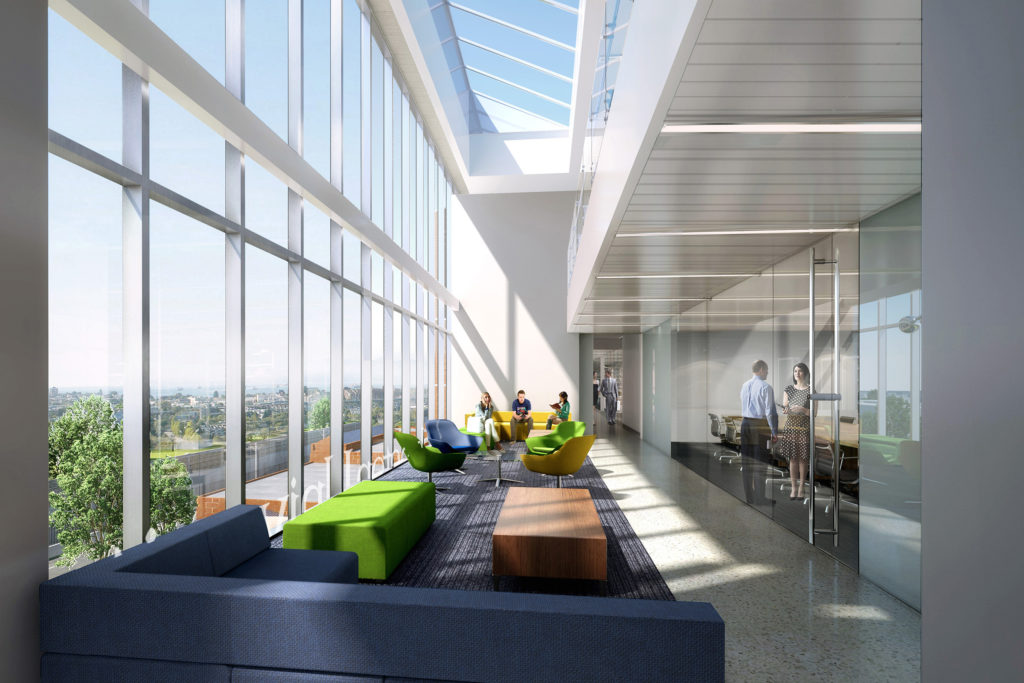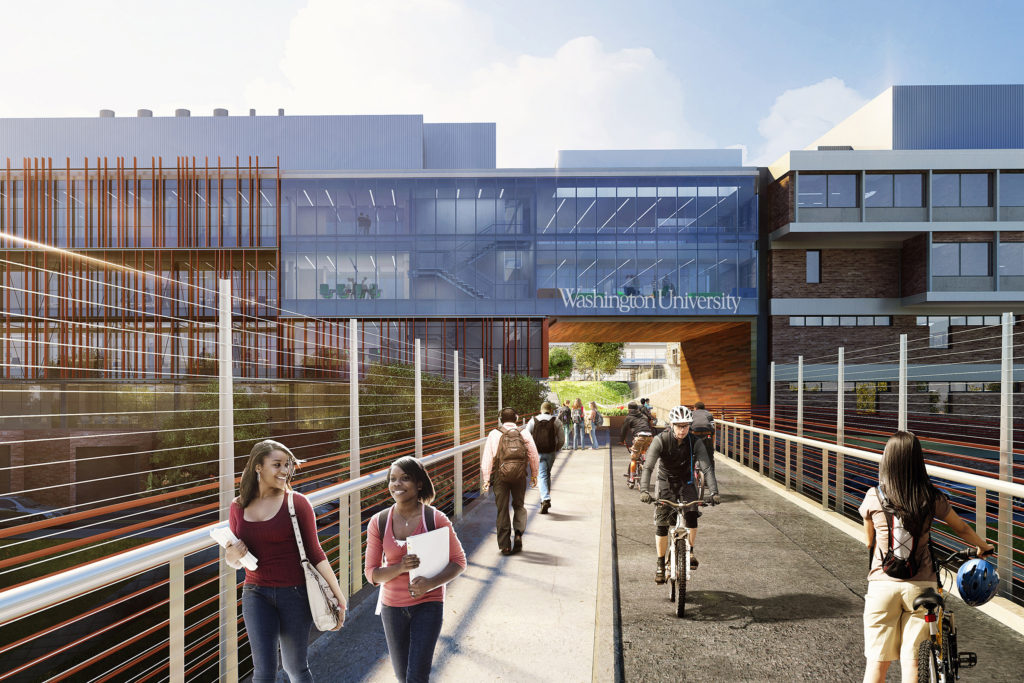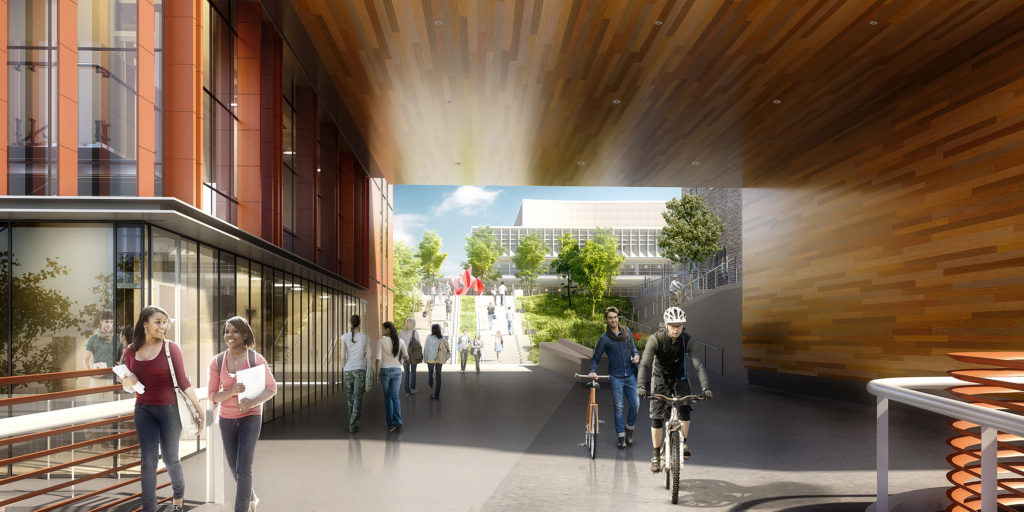
A new era of scientific discovery is being launched at Washington University in St. Louis that will transform teaching, research, faculty and facilities in Arts & Sciences.
Driving Discovery is an ambitious multiphase project in Arts & Sciences that will create new research and teaching facilities for the sciences.
The decades-long project will transform not only the way the school trains scientists and makes discoveries, but also the look of the north side of the Danforth Campus.
“Driving Discovery will create an ecosystem — an interconnected community of scientists and students working in state-of-the-art facilities — that fosters innovation and collaboration,” said Barbara A. Schaal, dean of the Faculty of Arts & Sciences and the Mary-Dell Chilton Distinguished Professor in the Department of Biology in Arts & Sciences.
“This ambitious effort will empower research across disciplinary boundaries — not just among all the natural sciences, but also some social sciences like anthropology and psychology, as well as exciting new collaborations with the School of Engineering & Applied Science and the School of Medicine,” Schaal said.
“Today, we face a new imperative — to pursue solutions to complex challenges through interdisciplinary collaboration,” she continued. “We’re hoping that this initiative will lead to a new era of discovery.”
Chancellor Mark S. Wrighton added: “The scientific enterprise at Washington University is among the world’s most fruitful. For this rich tradition of inventive, insightful research to continue at an unbroken pace, we must maintain and expand our leadership in basic science,” Wrighton said. “The benefits of this initiative will extend far beyond our campus, creating a brighter future for all.”
Creating collaborative spaces
Schaal said that the initial focus of Driving Discovery will be renovating outdated science facilities and replacing them, in an efficient and sustainable way, with state-of-the-art laboratories, teaching areas, and collaborative, flexible spaces that foster collaboration and meet the needs of today’s scientists.
To successfully recruit and retain talented faculty and students, she said, the school must provide infrastructure that can support modern research technology.
“Currently, departments are physically removed from each other, severely limiting the degree of spontaneous interaction,” Schaal said. “As the nature of research questions change, we need to have core facilities where large multi-user instruments will be housed to provide state-of-the-art, shared instrumentation in computation, imaging, molecular structure and genomics.”
A phased, incremental plan by architectural firm Ayers Saint Gross will repurpose older buildings starting with Bryan Hall, which was built in 1965 and, until recently, housed departments for the School of Engineering & Applied Science.
Located on Throop Drive on the north side of the Danforth Campus, Bryan Hall will become the new face of the Department of Chemistry in Arts & Sciences.
The comprehensive renovation of the five-story, 59,000-square-foot building will begin this summer, with completion scheduled for May 2018.
The renovation will add more than 25,000 square feet of new research space for chemistry and include state-of-the-art spaces for three existing research groups and room for seven additional groups to be recruited over the next several years.
A new connection between Bryan Hall and the existing chemistry facilities in McMillen Hall will also be built on levels four and five.
Bryan Hall’s north-facing façade will be updated and, eventually, the facades of several other existing buildings on the university’s Throop Drive will also be updated to provide a cohesive look and a new, welcoming entrance to the Danforth Campus from Forest Park Parkway.

Supporting world-class education, discovery
Schaal said that Driving Discovery is a long-term plan that includes recruiting and retaining a diverse faculty that combines cutting-edge research with a passion for teaching; increasing resources for graduate fellowships and undergraduate scholarships; and creating new research opportunities for graduate and undergraduate students.
Essential to recruiting and retaining the best faculty and students, she said, is to create world-class facilities.
“Great faculty members attract exceptional students,” Schaal said. “Driving Discovery will support faculty growth in the sciences. Today’s scientists are trained in sophisticated methodologies and modes of inquiry. They need the resources and infrastructure that support world-class education and discovery.”
A generous commitment to support endowed professorships in the sciences will help significantly toward Driving Discovery’s goal of attracting and retaining world-class scholars.
Mike and Tana Powell, who have been actively engaged at Washington University since their daughter Landis enrolled in the Class of 2016, recently committed $8 million to match gifts for endowed professorships in the Department of Chemistry and other critical disciplines.
“Endowed professorships include resources that make it possible for faculty to establish research programs that attract talented graduate students and other leading scholars to our campus,” Schaal said. “Income from these permanently invested funds ultimately enable faculty to pursue studies that can have a lasting impact on society. We are grateful to the Powells for their support toward that endeavor.”
“The Powells’ visionary support for new professorships in chemistry and related fields holds extraordinary potential for future impact in science and technology,” Chancellor Mark S. Wrighton said. (See related story on the Powells’ gift.)
Ultimately, Driving Discovery will extend beyond the sciences and address needs to increase the research and teaching profiles of all Arts & Sciences disciplines.
Planning for this new integrated science initiative began in 2011 after a two-year-long benchmarking study, requested by Wrighton and conducted by the faculty of Arts & Sciences, concluded that modern facilities and advanced equipment are crucial to do research that can have significant impact and that the school’s current science infrastructure is not suitable for today’s research demands.
The findings from the benchmarking study were outlined in a report, “Arts & Sciences, Strategy for Excellence in Sciences.”
“Universities are the greatest engines for opportunity and by far the best environments for bringing together the people and ideas needed to solve the world’s most urgent problems,” said Holden Thorp, provost and the Rita Levi-Montalcini Distinguished University Professor in Chemistry and Medicine.
“We provide basic research that forms the foundation for tomorrow, and Driving Discovery will enable Washington University to remain at the forefront of this essential work.”

Forest Park Parkway bridge enhancements
In conjunction with the Bryan Hall renovation, the university will replace the pedestrian bridge over Forest Park Parkway with one that will improve pedestrian access as well as enable safe bicycle and handicapped access to communities and services north of the Danforth Campus.
The bridge, an important leg of the Centennial Greenway, will have a wider corridor with separate bicycle and pedestrian paths.
The bridge design complements the Driving Discovery building enhancements and is a key component to the re-envisioned north “gateway” to the Danforth Campus.
Construction will begin this summer on the bridge’s south end that spans across Throop Drive and will include enhancements to Millstone Plaza, which is south of Bryan and McMillen halls and leads up to the planned new north entrance to Olin Library.
Construction on the northern part of the bridge over Forest Park Parkway is scheduled for summer 2017.
Said Henry S. Webber, executive vice chancellor for administration: “In designing a new pedestrian and bicycle bridge and a facade for Bryan Hall along Throop, the architects created a design that seamlessly and safely connects inner campus across Forest Park Parkway, creating a convenient and attractive connection that will set the tone for future projects.”
